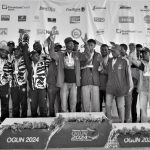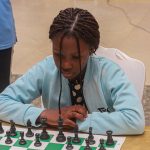In November 2018 I had the opportunity to visit Singapore. I was excited to visit this country again as I had previously visited in 2008 during a chess tournament. I was part of a team that presented a bid to host the 2023 Netball World Cup in Cape Town, South Africa. We arrived in Singapore on a Saturday morning and for the next few days we prepared and presented on Monday 26th November. The outcome will be made known in March 2019.
All ideas grow out of other ideas – Amish Kapok
I then continued with a short stay in Singapore so that I could visit the various places that I had read about. On Tuesday 27 November I started off by going to the National Gallery located at 1 St Andrew Street. The fee was thirty Singapore dollars which is equivalent to R300. The lady at the counter asked for a copy of my flight ticket and when I showed her the ticket she immediately gave me an 8 dollar tourist discount! I decided to start with the Minimalism Exhibition. It is described in the brochure as “Minimalism was a radical turning point in the history of art. Emerging in the 1960’s, it changed how we experience the physical encounter with the artwork and its surrounding space increasingly important. It has had a profound influence not only on visual art, but also on music, performance, fashion, architecture and design. The exhibition in Singapore was one of Minimalism. Space. Light. Object. It looked at the development and legacies of minimalism from the 1950’s to the present day, not only in the USA, but also in Asia, Australia and Europe.”
Now when I was confronted with this exhibition I thought about the movie Mrs Doubtfire. In that movie the late Robin Williams is visited by his former wife and children who asked him where his furniture is. He replied in the vein of: “it’s a minimalistic look!”So in I went to discover how Minimalisms reconception of the relationship between object, space and the viewer is fundamental to our understanding of art today. I saw quite a number of interesting ideas but the one that captured me was by Tatsuo Miyajima called Mega Death. It is described as follows:
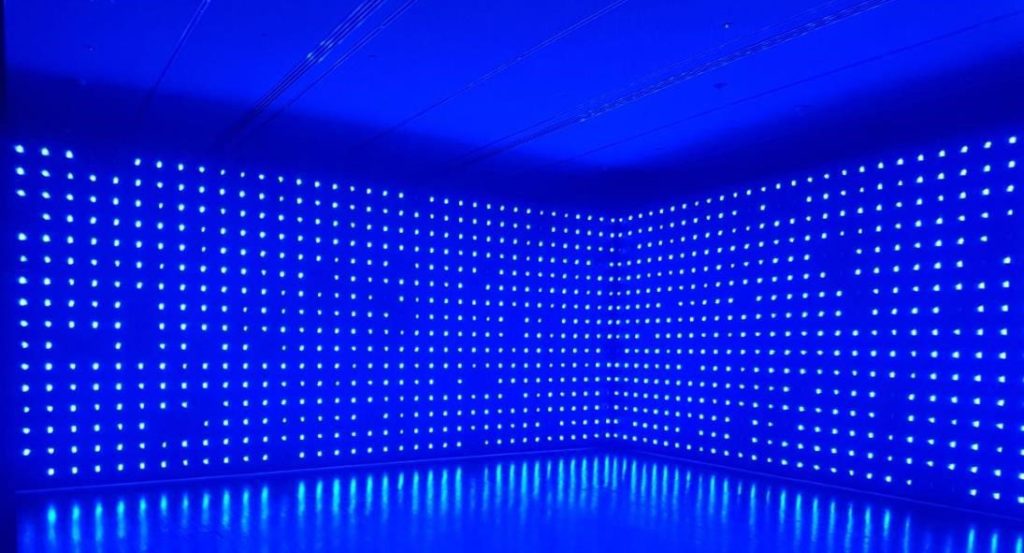
Mega Death
“Mega Death comprises three walls of numerical counters made of LED lights which count down repeatedly from nine to one. The number zero is replaced by a brief moment of darkness, representing the pause – between life and death, before the life cycle begins again. Miyajima calls the lights “the radiance of human life” which goes through perpetual cycles of change and cessation: birth, death and renewal.
I meandered through the National Gallery and enjoyed the various exhibitions. I made my way through the levels to level 3 where the Japanese forces surrendered to Mountbatten in 1945. The level is at the City Hall fourteen years later Lee Kuan Yew chose those steps to address the newly found self government for Singapore. I ventured up to the roof garden which has spectacular views of the Padang, with Marina Bay Sands opposite the National Gallery. I visited the Supreme Court section as well which was built in the 1930’s. Great care has been taken to preserve many of the neoclassical style of the 1930’s.

Japanese
surrender room
I visited the National Library in Singapore which is situated a short way distance from the South African embassy. The library is about ten floors high and is a very impressive building with modern architecture with everything that one desires in a library. I noted that they have on a monthly basis a talk by one of Singapore’s writers who would talk about topical books. They have also introduced a system whereby children can collect cards similar to what we know in South Africa when you go to some of the supermarkets. The system is known as the Book Bugs and a child receives a card each time they take a book out. The library also has an Oral history section called Preserving memories and also has a twenty four book return centre. Of course the library will also send you an email when you are late to return any book!
I strolled
around what is commonly called the Old Colonial section where I saw the statues
of Sir Stamford Raffles. It is said that he entered Singapore in February 1819
and wanted to secure Singapore for British influence against the Dutch and
other European powers vying for power and influence. Later that afternoon I
visited the Long Bar at the Raffles Hotel where I had the mandatory Singapore
Sling amidst the old fashioned elegance of the bar where Ngiam Tong Boon invented
it in 1915. The Raffles Bar informs us “It is said that because of the
prevailing social etiquette at that time, ladies could not consume alcohol in
public. The talented Ngami saw a gap in the market and decided to create a
cocktail that looked like a fruit juice. The gin based cocktail ale also
contains pine apple juice, lime juice, Curacao and Benedictine. Giving it the
pretty pink hue are grenadine and cherry liquor. Masking it in pink gave a
feminine flair and together with the use of alcohol, he cleverly led people
into thinking it was a socially acceptable punch for the ladies!”The bar
reminded me of that old television series Tales of a Golden Monkey which was
set in the early part of the last century.
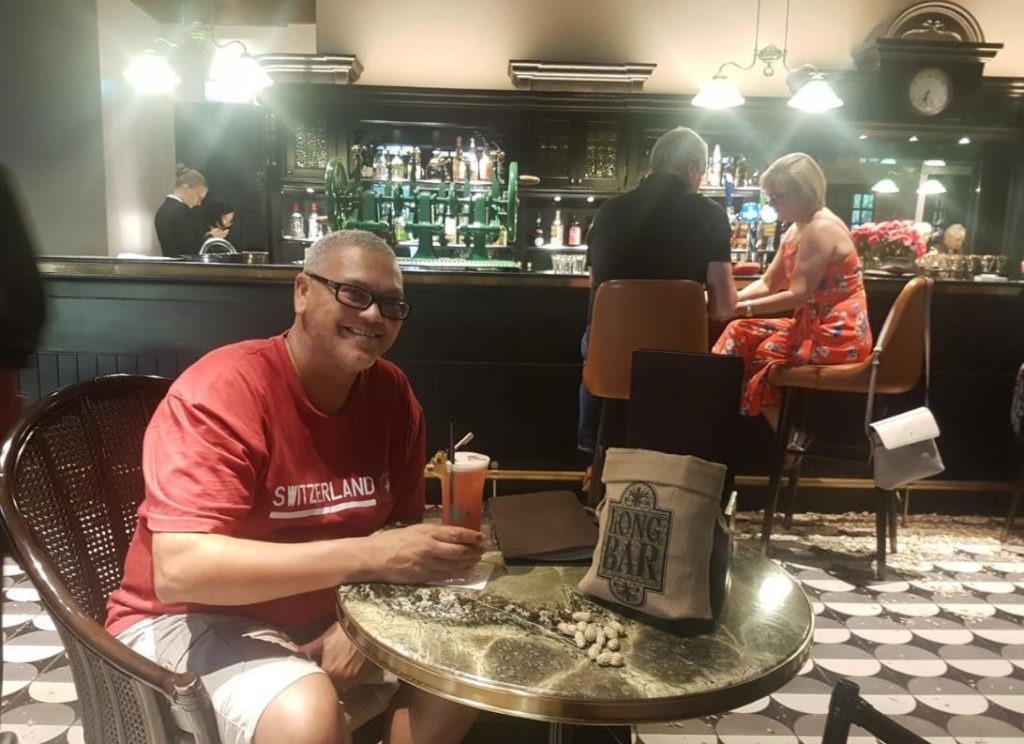
Long bar in
Raffles hotel
Next to the statue of Sir Raffles the Asian Civilisations Museum is located at 1 Empress Place. I decided to visit the museum because I wanted to know more about Asia. As I had time I decided to wait for the guided tour. We started the tour by looking at different religions in Singapore. All the world’s major religions have found resonance in Singapore through the ages. Fascinating statues and paintings adorn the various rooms of the museum.
The most fascinating discovery however was the Tang Shipwreck which was discovered in 1998 just off the Beitung Island on the edge of the Java Sea. It contained a remarkable cargo of more than
60 000 ceramics produced in China during the Tang Dynasty (618-907) as well as luxurious objects of gold and silver. The ship was bound for Iraq and Iran and provides early proof of the strong commercial links between China, South East Asia and the Middle East.
The guide explained to us the ceramics and porcelain and what it meant at that time. One of the important discoveries for me was that there existed a maritime Silk Route as well as an overland one. We always associate the overland Silk Route with China and Central Asia. Now the Tang shipwreck provides evidence of the important role of the sea route as early as the 9th century. The map in the museum shows the importance of the sea routes.
The sheer scale of the cargo aboard the shipwreck shows the great popularity of Chinese ceramics in foreign lands in the 9th century, the ability to mass produce thousands of nearly identical ceramics, an internal shipping network that gathered products from all over China at one port, and a financial system that invested and shared profits from the cargo
The guide then showed that the cups had a straw like feature which was used to drink wine. The wine was not drunk conventionally but was drunk through the straw like feature through the nose! Chinese poets and writers wrote about this and I quote “
Su, oh Su
Sing me the Song of the Willow Branch,
And I will pour you wine in that golden cup,
And take you with me to the Lank of Drunkenness.
-Bai Juyi, “Song of Past Feelings” (around 840)

Cups with
straws for wine drinking
The museum showed all the various countries in South East Asia. It also has a brief history of the Dutch East India Company who also played a significant role in South Africa. The museum notes “that the Verenigde Oost-Indische Compagnie (VOC) flourished for nearly two centuries (1602-1795). A commercial venture, given free reign by the Dutch government, the VOC developed into one of the biggest and most powerful trading and shipping firms of the 17th and 18th century.”
As we were ending the tour, I discovered a game board which according to the note attached is said to be a game board from South Asia, Gujarat or Sindh, 16th century ivory, wood and metal. One side of the board was used for chess, the other side for parchisi. Brackets along the borders kept the game pieces in order. The object is decorated with complex mosaic patterns made up of various types of ivory, wood and metal.

Board in museum
The
next day I visited Mr. Ignatius Leong. I have known Mr. Leong since 2002 when I
was the coach of the SA U/16 Olympiad team that played in Malaysia. He was the
main organiser of that event. He was at one stage of his career Secretary
General of Fide. I visited him at his offices where we chatted for some time
about chess history, the current issues of draws in chess and how to improve.
He was of the opinion that we chess should be played until a result is
achieved. We exchanged books about South African and Singapore chess. I have
vowed to read the Singapore chess book in the vacation. I shall next month upon
the completion of the read write about Singapore chess.
We then visited his home where he showed me the most beautiful chess sets that he had collected in his travels. I love chess sets and between my wife and I, we own many beautiful chess sets that we bought from around the world. The chess sets Mr. Leong was showing me were primarily made in the east and had distinct Asian features. He generously gave me one of the chess sets to take back to Cape Town which is now prominently displayed in my home. Mr. Leong played against South Africa at the 1998 Olympiad in Kalmykia.
There were however two chess sets which he showed me which I did not know much about. The Thai chess set and the Cambodian chess set. I did not know that there were so many variants of chess. I knew about Chinese chess but did not know about the above two. Thai chess or makruk is a board game that descended from the 6th century Indian game of chaturanga or a close relative thereof, and therefore related to chess. The opening set up is similar to that of orthodox chess, with the positions of the white king and queen is reversed, and all pawns are on the third or sixth row.

Thai chess set
Cambodian chess is virtually identical to Makruk with a couple of minor differences. If no pieces have been captured, the players have the options on the king’s first move, and only of not in check, of moving the king like a knight and on the queen’s first move, of moving the queen two squares straight ahead.
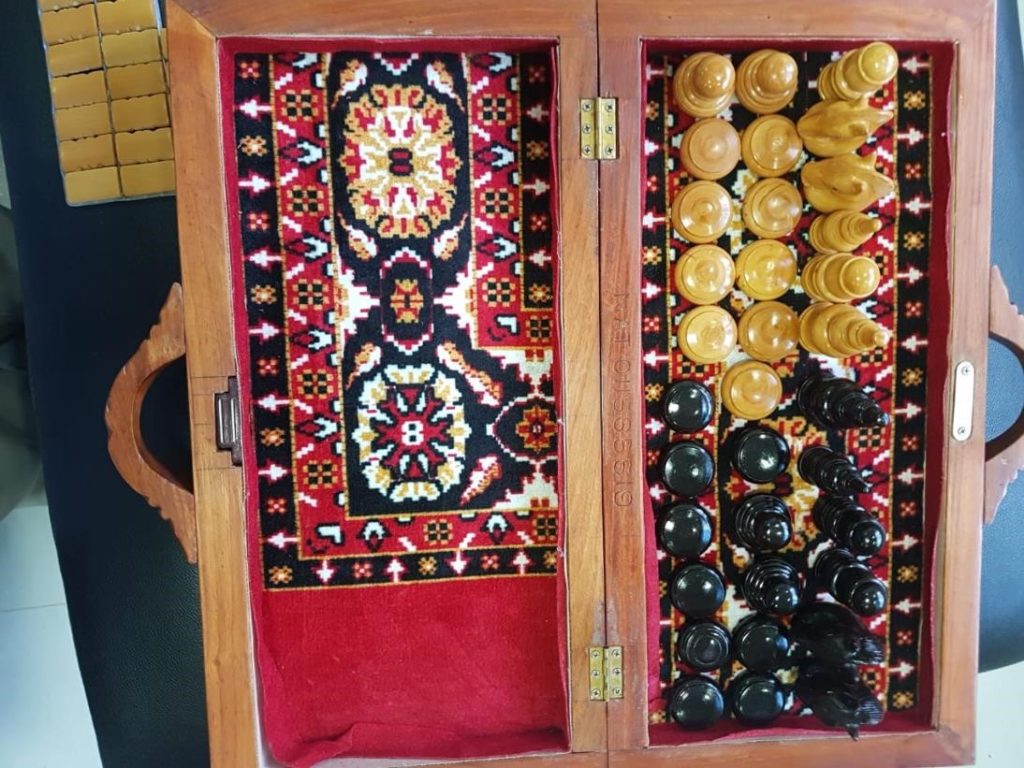
Cambodian chess set
I visited Little India where of course I had to visit the Mustafa Centre where I bought a few items. I naturally had to try the Tandoori chicken one lunch time! I then proceeded to the Botanical Gardens where I indulged in simply just appreciating the natural beauty of the Botanical Gardens. The Botanical Gardens were founded in 1859. It reminded me of Kirstenbosch Gardens in Cape Town complete with the spot where concerts are held as well.
The Gardens
brought me to Orchard Road. The first place that took my fancy in Orchard Road
was Starbucks where I decided to indulge in their coffee and some afternoon
delights. One must have coffee after that Tandoori chicken you know! Orchard
Road really has some fancy stores and of course is a shopper’s paradise. I
spent some Singapore dollars on some chess books and on the Singapore Story.
The Singapore Story is the memoirs of Lee Kuan Yew who is the modern day
founder of Singapore. In the Singapore story he tells the reader how modern
Singapore came about and takes us back to his childhood, the Japanese
occupation and the politics surrounding the founding of modern Singapore. I
bought the abridged version so I shall have to purchase the full memoirs
because the story ends in 1965 before Singapore undertook its economic miracle.
A month before I visited Singapore I watched the movie Crazy Rich Asians. It is a romantic comedy that tells us about the visit to Singapore by an Asian American. It showcased many of Singapore’s finer points and I was determined to see some of those sites as well. I walked to the Marina Bay Sands passing the Merlion. The Merlion is a mythical creature with a lion’s head and the body of a fish that is widely used as a mascot and national personification of Singapore.

The Merlion
I visited the upper deck of the Marina Bay Sands casino and shopping centre. It had a wonderful panoramic view of the old Colonial district of Singapore. At 8pm a twenty minute water show was held which I viewed from the 56th floor. The show was spectacular. Featuring water and lights it provided a vibrant backdrop of the modern Singapore.

Marina Sands
Bay
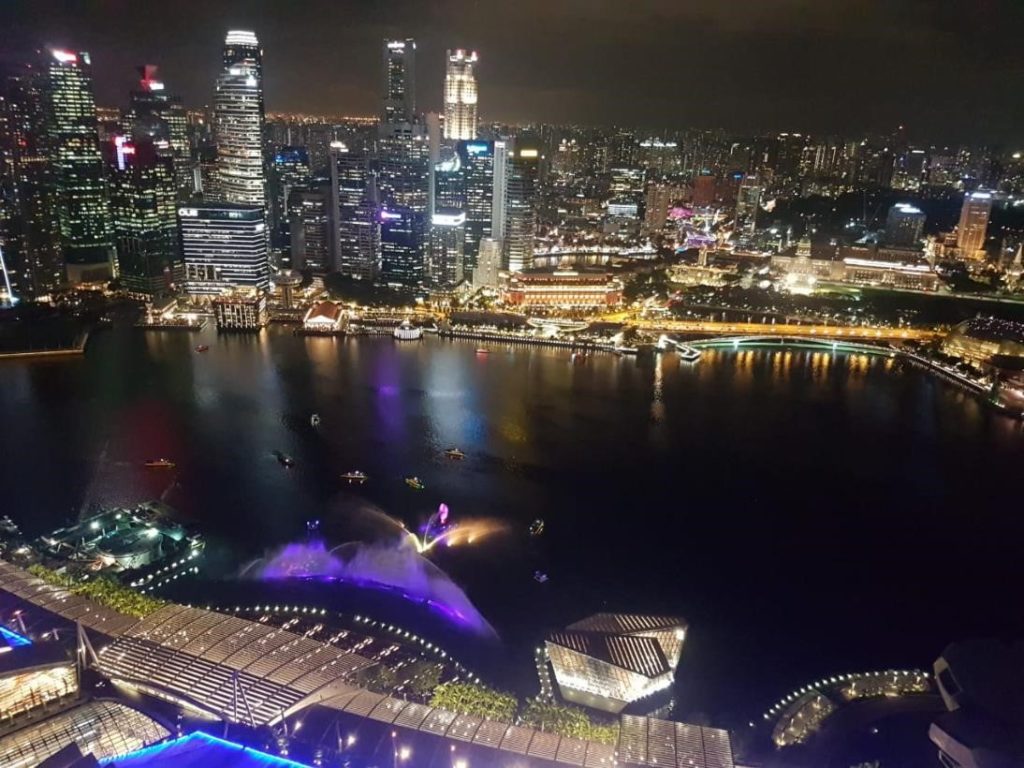
Water show
Singapore is modern in every way possible. From the museums, to the use of space on roof tops where tennis courts are built, to the supper efficient transport system I found it very easy to get around. Louis, at my hotel, would simply state, take the 55, 25, 76 buses to Paya Lebar train station, then take the downtown line and then cross over at such and such station. The stations were wheel chair friendly and people were kind to assist me when I needed to be helped.
My last day
left quite an impression on me. I decided to make the early journey to Sentosa
Island. On Sentosa Island there is a myriad of activities from Universal studio
replicas to the maritime museum. I decided to dispense with Universal Studios
and rather go to the Maritime Experiental Museum and S.E.A Aquarium. When I
entered the museum I was greeted by four larger than life characters, Ibn
Battuta from Morocco, Zheng He from China, Marco Polo from Italy and Sang Nila
Utama from Indonesia. Now I was very excited because almost everyone knows
Marco Polo…but the other three characters are largely unknown.
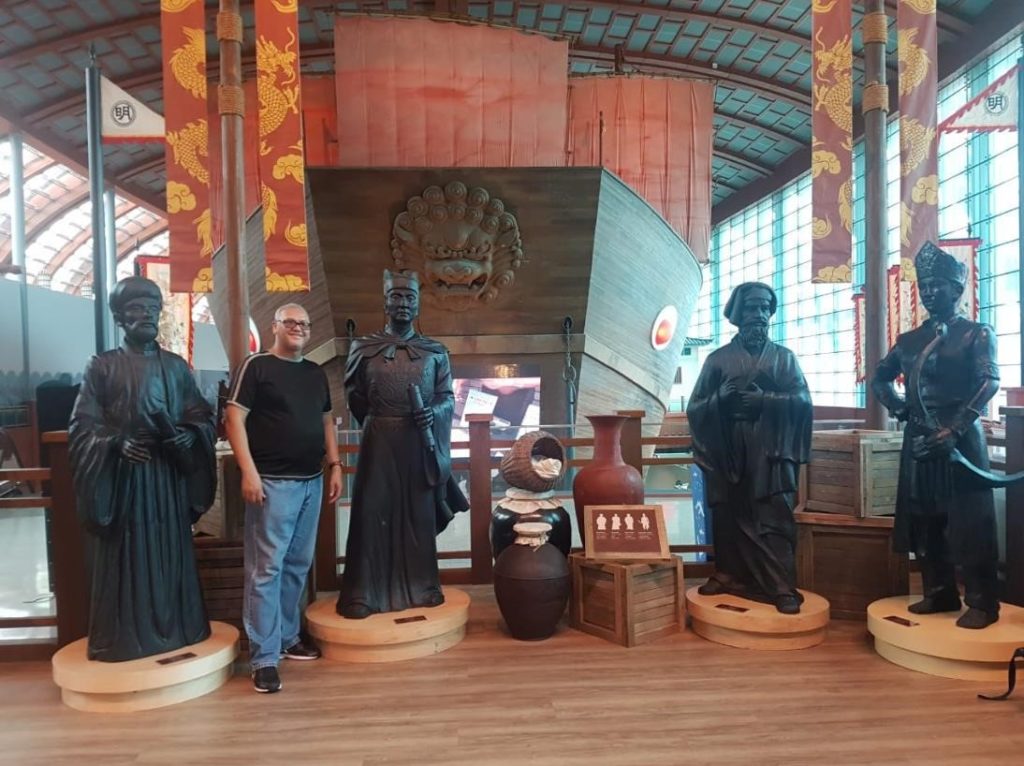
The explorers with me next to Zheng He
The museum stated that it believes that “
Maritime history refers to the study of human activities at sea from past to present. These activities include fishing, designing and building sea vessels, developing tools and methodologies in the fields of navigation, oceanography, cartography and hydrography; naval engagements, sea explorations and the development of trade and sea related communities. By knowing maritime history, one learns about the progress of humankind, the rise and fall of civilisations, how different cultures and people interacted with one another, and the origins of many of the things, we eat and use today. Most of all maritime history tells us more about who we are as a species.”
The museum starts off with holograms where the four explorers tell us about their journeys. San Nila Utama ( ruler from 1299-1347) was a Srivijayan prince from Palembang who is said to have founded Singapura in 1299, Marco Polo, a merchant of Venice released a book about his travels and life in China, Ibn Battutua ( 1304-1369) is an African Berber Muslim sea farer, scholar and explorer who travelled widely in the medieval world. Over a period of thirty years, Ibn Battuta visited most of the Islamic world and many non Muslim countries including Central Asia, South East Asia and China.
The fourth
explorer Zheng He tells us about his journeys and I was intrigued when I
explored the maps in the surrounding rooms. He was a Chinese mariner, explorer,
diplomat, fleet admiral during China’s early Ming Dynasty. The map shows Zhenh
He travelling to Mogadishu (Somalia). I knew this couldn’t be correct because I
have a copy of the book 1421 by Gavin Menzies (2002). Let’s have a
look at Menzies book. On 8 March 1421, the largest fleet the world had ever seen set sail from China. The ships, some nearly five hundred feet long, were under the command of Emperor’s Zhu Di’s loyal eunuch admirals. Their orders were to ‘proceed all the way to the end of the earth’. Admiral Zheng He sailed on this day as well. Menzies found a map drawn in 1459 by Fra Mauro, that showed the Cape of Good Hope (Cap de Diab). The author goes on to show that Admiral Zheng he travelled all the way to the Cape Verde Islands. This is of course astounding because of course we only learnt about Diaz and Vasco Da Gama at school and yet in 2021 the 600th anniversary of China rounding the Cape will be upon us! I enjoyed the museum because it showcased the Maritime Silk Roads of the oceans and they had many references to Africa. The Chinese National Museum in Beijing also has references to Zheng He rounding the Cape in 1421.
Thank you Singapore for making me think afresh about many facets of life in South Africa!
If my art has nothing to do with people’s pain and sorrow, what is art for? AI Weise
Enjoy the New Year
Regards
Dr Lyndon Bouah
December 2018











